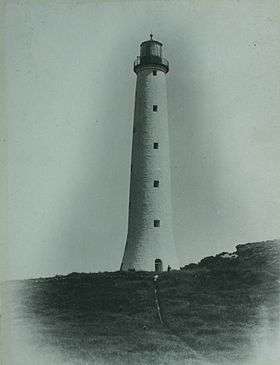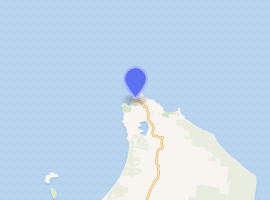Cape Wickham Lighthouse
The Cape Wickham Lighthouse is a lighthouse situated at Cape Wickham on King Island, Tasmania. At 48 metres (157 ft) tall, it is Australia's tallest lighthouse.[2][3] The lighthouse is listed on the Commonwealth Heritage Register.[2]
 The lighthouse in 1887 | |
 Cape Wickham Lighthouse Tasmania | |

| |
| Location | King Island Tasmania Australia |
|---|---|
| Coordinates | 39°35′18.7″S 143°56′34.7″E[1] |
| Year first constructed | 1861 |
| Automated | 1918 |
| Construction | stone tower |
| Tower shape | cylindrical tower with balcony and lantern |
| Markings / pattern | white tower and lantern |
| Tower height | 48 metres (157 ft) |
| Focal height | 85 metres (279 ft) |
| Light source | 1,000 watts (1.3 hp) 120 electronvolts (19 aJ) Tungsten Halogen Lamp |
| Intensity | 550,000 cd |
| Range | 24 nautical miles (44 km; 28 mi) |
| Characteristic | Fl W 10s. |
| Admiralty number | K2186 |
| NGA number | 6936 |
| ARLHS number | AUS-050 |
| Managing agent | Australian Maritime Safety Authority |
| Heritage | Commonwealth Heritage Register |
There are eleven timber flights of stairs in the lighthouse, with twenty steps each, which must be climbed in order to reach the top. Surrounding the lighthouse are the remains of a number of associated buildings, including a small church. There are also a number of gravestones, many belonging to those who were shipwrecked in the area after the lighthouse was built.[3]
History
The lighthouse was originally established in 1861,[4] in response to the sinking of the barque Cataraqui sixteen years earlier, a disaster which had resulted in the deaths of 400 people.
While it was being constructed, some worried that the lighthouse would cause more shipwrecks than it prevented, as lighthouses usually showed the way to safety rather than warning of danger as the Cape Wickham lighthouse was designed to do. Nonetheless, the lighthouse was eventually completed, although shipwrecks frequently continued to occur until the Currie Lighthouse was completed in 1879.[5] Built from locally quarried stone, the lighthouse was manned by a superintendent until the light was automated in the 1920s. The superintendent often came into conflict with hunters and other established inhabitants of the island, with one 1873 report stating:
There are certain lawless men who have taken up their residence on the island who make a practice of annoying the Superintendent in every possible way, destroying his cattle, pulling down the fences and taking his hay and in fact they say they are determined to make the place too hot for him, and I much fear it will end in some serious injury to the station or perhaps to the light itself.
— from Guiding Lights by Katherine Stanley[3]

The superintendents were required to be extremely self-sufficient, as only one supply ship visited the site a year. Some of the lightkeepers resorted to looting and theft to supplement these supplies, with one keeper being dismissed for storing goods that his brother had looted from a shipwreck.[3]
In the 1920s, it was determined that it was no longer necessary for the light to be manned on a full-time basis, and automation systems were added to the lighthouse. At this time, a number of the surrounding buildings were also demolished, including the superintendent's residence. The lighthouse continued to be looked after by the lighthouse keeper from nearby Currie.[3]
During preparations for the 150th anniversary of the lighthouse, it was discovered that it had never been officially opened.[6] To rectify this oversight, Australian Governor-General Quentin Bryce officially opened the lighthouse in a ceremony on 5 November 2011.[7]
References
- "Cape Wickham Lighthouse". Lighthouses of Tasmania. Lighthouses of Australia, Inc. 14 May 2003. Retrieved 3 June 2015.
- "Commonwealth Heritage Places in Tasmania". Department of Sustainability, Environment, Water, Population and Communities. Retrieved 6 November 2011.
- Macdonald, Michael. "The Cape Wickham Lighthouse on King Island". Retrieved 6 November 2011.
- "NOTICE TO MARINERS". Launceston Examiner (Tas. : 1842 - 1899). Tas.: National Library of Australia. 3 September 1861. p. 4 Edition: MORNING. Retrieved 2 December 2013.
- "Cape Wickham Lighthouse". Retrieved 6 November 2011.
- Foster, Margot (4 November 2011). "Cape Wickham lighthouse turns 150". Australian Broadcasting Corporation. Retrieved 6 November 2011.
- "Governor-General of Australia :: Events :: Governor-General opens Cape Wickham Lighthouse". Office of the Governor General of the Commonwealth of Australia. Archived from the original on 27 February 2012. Retrieved 6 November 2011.
External links
| Wikimedia Commons has media related to Cape Wickham Lighthouse. |